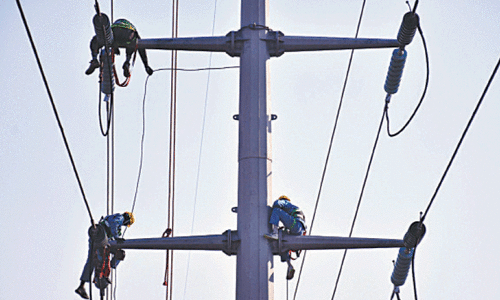IN its quarterly report on Pakistan’s economic performance, the IMF made public a delay of at least six months in Islamabad’s privatisation programme. This schedule would be too close to the conclusion of the fund’s 36-month, $6.4bn programme.
To be precise, the final tranche of Extended Fund Facility is due for disbursement in August 2016, while almost all privatisation transactions have been delayed until end-June or end-September 2016. This would mean that the fund would have little influence at the time to push authorities to end the bleeding of public sector entities
For example, the divestment of shares in PIA, Kot Addu Power Company, Mari Petroleum and Pak-Arab Refinery have been postponed until end-June 2016 instead of December 2015. Similarly, the strategic sales of electricity supply companies of Faisalabad, Islamabad and Lahore, as well as the Northern Power Generation Company Ltd, have been delayed until end-September 2016 instead of their previous deadlines of December 2015 to June 2016.
Only the schedule of the easier 10-15pc divestment of the government’s shares in the State Life Insurance Company Ltd has been advanced by three months to March 2016.
The schedule of the easier 10-15pc divestment of the state’s shares in the SLIC has been advanced by three months to March 2016
“Following delays in the planned privatisation of public sector enterprises, follow-through on revised privatisation plans and a commitment to restructure key loss-making enterprises will be essential,” the IMF has warned.
The fund also seemed to be putting too much hopes on the China-Pakistan Economic Corridor (CPEC) to spur economic growth in the country, even though its focus appeared on limiting public sector development investment to keep the fiscal deficit within manageable limits.
Meanwhile, the power sector’s poor performance remained stubborn, as the IMF noted no reduction in system losses and a 1pc fall in recoveries and a higher stock of circular debt. This was based on Finance Minister Ishaq Dar’s report that the total circular debt stock had increased by about Rs33bn between end-March and end-June to Rs648bn.
In its previous quarterly review, the IMF had noted an easing of risks. But it reported that downside risks had increased after June 30. Some key downside risks included slippages in policy implementation, legal challenges to power surcharges, and the still-challenging political and security conditions, which could affect economic activity and undermine fiscal consolidation.
Despite some slippages in meeting targets, the IMF appreciated the authorities for making significant progress over the programme’s period in addressing fiscal imbalances and building forex reserve buffers, supported by lower oil prices and lower untargeted power sector subsidies.
However, the public debt remains high; the tax-to-GDP ratio is (despite some recent progress) among the lowest in the world; private investment is still well below desired levels; and exports have declined from an already low base.
In addition, the appreciation of the real effective exchange rate has been eroding competitiveness.
The IMF said strong reform implementation will be needed to reinforce the recent gains in economic stabilisation and to sustainably raise growth, and it asked the authorities to be prepared to take measures as necessary to keep the fiscal programme on track.
“In the event that projections at the time of the ninth review show a fiscal gap, planned tax-base broadening measures should be pulled forward and implemented promptly,” the fund said. “Power sector reforms should be swiftly implemented,” it added while releasing the $504m tranche recently. It noted that securing reliable and continuous supply of electricity, improving the system’s efficiency, and moving the sector to cost recovery will be critical for growth and continued fiscal consolidation.
Swift reduction in losses and improved recoveries will unlock existing idle generation capacity and reduce the potential drain from such arrears on public resources, said the IMF.
The lender also believed that the CPEC will initially connect western China (Kashgar) with the south of Pakistan (Gwadar) through a series of infrastructure and energy projects. It envisages an investment of $33.8bn in energy and $10.6bn in transport infrastructure.
The CPEC will cover the period till 2030 and will be reviewed for investments as it progresses beyond 2030. All transport infrastructure projects are expected to be completed by 2017-18, while priority energy projects — which will add about 10GW to overall capacity — are expected by 2017-18.
The fund noted that while transport infrastructure projects will be exclusively financed through government-to-government long-term loans on concessional terms, they will be executed within the overall envelope of the public sector development programme.
Energy-related projects will be based on foreign direct investment, financed by commercial loans from Chinese financial institutions to Chinese investors, who, in collaboration with Pakistani partners, will undertake the construction of all projects. And the Pakistan government will guarantee energy sales through power purchase agreements.
Published in Dawn, Business & Finance weekly, October 12th, 2015
On a mobile phone? Get the Dawn Mobile App: Apple Store | Google Play













































